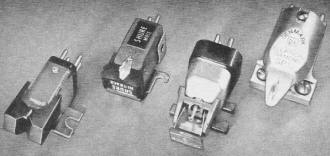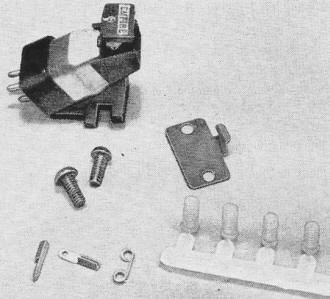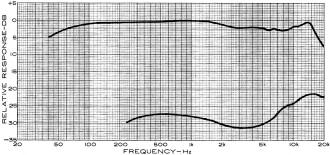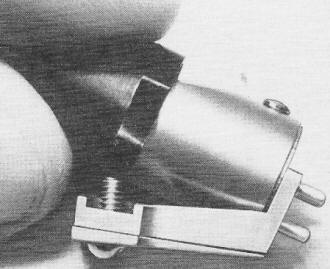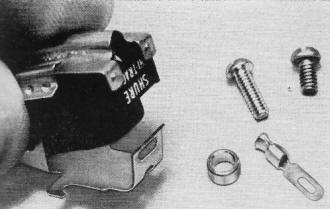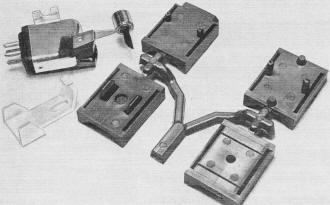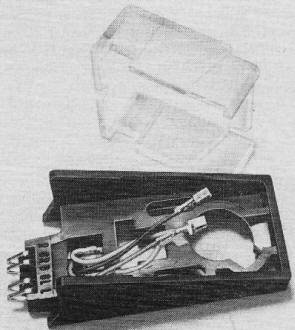15 Things We Do Know About Phono Cartridges
|
|
As the planet's population grows older and people have an increasing amount of disposable income and spare time, the opportunity to engage in nostalgic endeavors has gone up. That includes collecting, restoring, and operating equipment and peripherals that were the mainstay of their lives during their halcyon days of youth. In recognition of the new marketing opportunities, industries are popping up to feed the frenzy. Look no farther than eBay and the amount of vintage items available for purchase - at ever increasing prices. Having myself been an eBay buyer of memorabilia from my early model airplane, model rockets, and electronics hobbies, I have watched prices soar in many cases. Turntables (aka phonographs, or for the lowbrow types, record players) are being manufactured again and vinyl records are bring pressed for some of the most popular 1960s and 1970s groups. Articles like this one are prime fodder for those wanting to resurrect their stuff. I recently restored a 1970s-era turntable that was part of a Reader's Digest special that fit my budget as a 16-year-old. * C-141 Turntable made by CSR, and the Model 800-XR AM/FM Radio + 8-Track Tape Player 15 Things We Do Know About Phono Cartridges
By J. Gordon Holt Who was the first person to suspect that it was impossible for a phono cartridge to track perfectly the indentations in a tiny groove on a recording? Possibly it was Edison since he undoubtedly encountered the problem. (Though the mechanical arrangement and materials he used were quite different from those we know today.) At any rate, through the years it has been calmly accepted that perfect tracking is impossible. For a while, designers of reproduction systems simply made the stylus do what they wanted it to by increasing the tracking force until the stylus had to stay put in the groove. .This had its obvious disadvantages; and, though today they still recognize the fundamental dilemma, designers have been learning what the problems are and finding better ways of circumventing them than by the use of brute force. Improvements in cartridge design are by no means the least important in the changes that have been made to get better tracking. While no cartridge is yet perfect, the past few years have seen an end to the worst imperfections that made disc reproduction an audiophile's headache. However, in picking a cartridge, be aware that they are not all the same - and not all equally good. So check yourself out on these fifteen points (arranged alphabetically for ready reference): Getting the Cartridge Mounted All four of the stereo phono cartridges shown on this month's cover use slightly different mounting techniques. Manufacturers have refined the process of cartridge mounting to virtually eliminate tracking error and still insure ease and convenience in performing what was once a nuisance undertaking. At right is the Empire 999VE/X, one of the more highly rated cartridges in $79 (list) price bracket. Two sizes of molded plastic screws are provided to secure cartridge clip to special mounting bracket (not shown). Cartridge is then easily snapped in place and leads connected. Stylus removal is also quite simple and nameplate guard shown in photo protects stylus in transit. Practically every cartridge you buy includes mounting hardware and some form of stylus protection. Frequency response graph above was made from test measurements on an Empire 999VE/X. Note the relatively smooth top curve which indicates the over-all left channel response. The lower curve shows response in the right channel due to crosstalk from the left channel-indicating stereo separation. A graph of phono cartridge response is usually published in magazine evaluation reports. Cartridge is the Danish import from B&O labeled SP 12 and selling for $69.95 (list). Like the Empire above it has an elliptical stylus. Note the removable wedge supplied by the manufacturer to correct cartridge mounting in a record changer where the record stacking would drastically alter the preferred 15-degree vertical tracking angle. The Shure M91E cartridge has an elliptical stylus with a metal guard - shown here under the photographer's index finger. Cartridge is partially disengaged from "Easy-Mount" snap-in bracket which would normally be attached to tone arm head or plug-in shell. As mentioned elsewhere, cartridges are supplied with a variety of mounting hardware and a few examples are shown here - mounting screws (two types with American and British threads), washer/spacers, and lead clips. Most record players and changers are sold with clips soldered to the fine wire leads passing through the tone arm - and color-coded to boot. Mounting has been simplified by standardizing on 1/2" (12.7 mm) center-to-center for the two retaining screws that hold the mounting bracket to tone arm shell. Pickering and Company has carried phono cartridge mounting ease one step further by supplying the buyer a variety of individualized "Snap-In-Mounts" cast from plastic (shown above with connecting plastic still in place). Starting from lower left and going clockwise, the mounts are for Dual, BSR, Garrard, and BSR Single Hole Heads. The cartridge itself is snapped into place on reverse side of each mount. Stylus guard has been removed and is seen near the cartridge. Note also the dust brush that is attached to cartridge. This is Pickering's model XV-15/750E cartridge selling for $65, list. Paralleling the efforts of cartridge manufacturers to simplify mounting, record player/changer manufacturers frequently provide additional information, mounting hardware, or even a special plastic guide. This is the tone arm cartridge mounting shell for a Dual 1219 - note the clips soldered to connecting wires. The guide (upper right in photo) is used to align accurately the depth and the stylus overhang to provide minimum tracking error. Compliance. As the stylus rides in the groove of a record, there is a great deal of actual contact pressure between the two. This pressure is a result of nothing more than the applied tracking force (which see) in an unmodulated groove. When the groove starts pushing the stylus around, contact pressures can rise considerably above 24 tons per square inch and the amount of rise depends on how much the stylus resists the groove's efforts to move it. When the resistance to movement is significant, groove destruction does take place, and the stylus starts to rattle around between the groove walls to produce the familiar shatter of tracking distortion. For many years, cartridge designers were convinced that both record wear and tracking distortion stemmed from excessive stiffness of the stylus's flexible mounting. Manufacturers tried to "out-compliance" one another until some styli were barely rigid enough to keep the tone arm following the stylus movement. Today, compliance is no longer the limiting factor in track ability of most cartridges - although some designs intended for use in second-rate tone arms are made to have less compliance than the top-flight precision products. High compliance didn't solve the track ability problem anyway; it just helped. Obviously, something else was involved, and the culprit now seems to be stylus inertia or moving mass (which see). Distortion. One of the difficulties in evaluating cartridge performance is the lack of meaningful measurements for audible distortion. Audio testing organizations customarily publish harmonic and intermodulation distortion figures, but these do not gauge what we hear as tracking distortion. They only measure things which usually (but not always) accompany it. Trackability measurements are more to the point, but these too are useful only for comparisons between different cartridges, since it is possible for one pickup that is tracking better than another to sound as though it were tracking worse - purely as a result of differences in other aspects of the reproduced sound. Very small amounts of amplifier distortion can make tracking distortion sound much worse than it really is, as can high-frequency peaks in the cartridge and/or loudspeakers; while a response dip in the upper frequency range can make a cartridge sound as if it were tracking more cleanly than it actually is. Durability. Few good cartridges will withstand a clumsy "finger-dusting", but the days when an initially excellent pickup would go to pot in a few months because of hardening of the flexible stylus suspension seem largely behind us. With today's stylus-saving low tracking forces, though, many cartridges will start to sound sour for this reason long before the stylus shows audible signs of wear. This is a bit of an annoyance but it is better than having a worn stylus chewing up discs before the wear becomes audible. Styli should be checked once a year anyway - just to make sure. Elliptical Styli. The elliptical stylus was a result of observations that, while high-frequency modulations are best followed by an extremely small-radius stylus, radii below a certain size tend to ride in the bottom of the groove instead of staying propped up between the groove walls. Combining small side radii with large front and back radii produced the elliptical tip. Ellipticals do generally sound cleaner in the inner grooves of "difficult" discs (compared to spherical styli), but the gain is not achieved without some losses. Because the stylus/groove contact area of an elliptical is smaller, contact pressure at a given tracking force is considerably higher. Reducing the tracking force can help to offset this, but it cannot cause a concomitant decrease in contact pressure against the walls of a modulated groove since the compliance and moving mass figures of an elliptical cannot be made any better than those of a spherical. As a consequence, the 0.7 X 0.2-mil elliptical that is tracking cleanly at around 1 gram will do more damage than a 0.7-mil spherical tracking at 3 grams. Only when the spherical is starting to mistrack on passages where the elliptical is clean will their rate of record wear be about the same. And a good spherical will track the vast majority of discs of serious music as cleanly as a good elliptical. So light tracking force alone is no guarantee of low record wear; the tracking force must be equated with groove/stylus contact area. Frequency Response. Of the qualitative measurements that can be made on cartridges, a check of frequency response reveals the most information about how a cartridge actually sounds - or how it makes the record sound. The sound should, of course, be as much as possible like that from the master tape from which the disc was cut, but the recent mania for improved trackability has tended to obscure the fact that most current designs do not produce sounds like those from the tape. And much of the blame for this lies with the elliptical stylus. Because of the differences in groove-contact characteristics, ellipticals tend to have a broad response dip in the "brilliance" range that sphericals do not. Thus ellipticals sound rather muted and "soft" by comparison. One of the most highly respected top-priced ellipticals, noted for its clean tracking, has a substantial dip in the brilliance range which, apart from making it sound dull, makes it sound cleaner tracking than it is. A second factor which is somewhat against ellipticals results from the fact that recording studios use spherical cartridges in judging what they're putting on their discs. The improved high-frequency tracing of the elliptical causes a rising high end on discs that were cut to sound flat. Some ellipticals do sound quite "tapey," though two of the most accurate disc reproducers available (Decca 4RC and Stanton 681A) are spherical. Magnetic Attraction. This was a problem when some cartridges (Ortofons, Deccas) were used with iron or steel turntable platters and the cartridge's magnet would draw it toward the platter causing a drastic and inconsistent increase in tracking force. It is seldom a problem today since virtually all transcription turntables and many record changers have aluminum platters. If in doubt, check the platter before using it with a cartridge that has its magnet or pole pieces close to the stylus tip. Moving Mass. This is another term for inertia - which is the mechanical characteristic that makes any object "want to" retain its present state of motion (or rest). When a disc groove is undulating 20,000 times per second (half cycle of a 10,000-Hz signal), it takes little stylus inertia to make the groove's task an impossible one. The lighter the stylus and its supporting member, the more readily it follows the groove's high frequency undulations, the less record wear there will be, and the cleaner the sound will be. Unfortunately, lightness entails fragility, so a practical stylus assembly must be a compromise. This is one area in which different cartridges have significantly different attributes and trackabilities. Noise. Until the vinyl disc was invented, subtleties of noise like amplifier hum and hiss were usually covered by the noise of the shellac record surface. Today's disc is virtually noiseless (when new), so the temptation to play it at high listening levels reveals hum tendencies that might have gone unnoticed as recently as five years ago. In response to this, cartridges and turntables now have better shielding than ever before so that, with a few notable exceptions, it is no longer necessary to "mate" cartridge and turntable for minimum hum. Price. The picture here has changed from what it was a few years ago when you had to pay top price for a cartridge that wouldn't butcher your discs. Prices at the top are still about what they were five years ago, but the money buys you a better cartridge. And of course, now you can buy a high-compliance, low-mass light-tracking cartridge (such as the Goldring G-850) for under $10. Record Wear. Low tracking force in itself is not what makes a cartridge easy on record grooves. What is important is the ability to track with a low force without incurring mistracking during loud passages since this is an indication that the stylus compliance is high enough and its moving mass is low enough to offer minimum resistance to the groove's thrusts. Obviously, stylus-to-groove contact pressure is lowest on each groove when the total applied force is equally divided between the two contact points. When the stylus encounters a modulation it can't follow readily, it tends to press more heavily against that groove wall and less heavily against the other. There still may not be serious groove damage, though, since vinyl is resilient enough to spring back somewhat after such an assault. But when the stylus meets a really impossible modulation, it tends to plow right in and lose momentary contact with the other wall of the groove. Each time it regains contact, it does so with tremendous pressure and an audible click. It is a rapid succession of these clicks that causes the shattering sound of acute mistracking. And the groove can't take this kind of abuse. Each click is a sign that the stylus has plowed too deeply into the modulation for the vinyl to recover and the resulting permanent indentations in the groove will continue to sound fuzzy under any condition. Since the groove is V-shaped, high tracking force helps to overcome the tendency toward momentary losses of contact with either groove wall, thus making the sound cleaner. But if the stylus is still plowing into modulations, fairly clean tracking is no assurance that the record isn't being damaged. It is the ability to track cleanly at a low force that is important, rather than the actual tracking force. A high tracking force accelerates record wear to a degree but the damage is not usually as great as that incurred when a cartridge is allowed to mistrack on an occasional disc. That is why, even though a cartridge may be able to track most discs cleanly at 3/4 of a gram, record wear may be less when tracking force is higher - perhaps 1 gram. Separation. Nearly all modern stereo phono cartridges with pretensions to fidelity have more than the 25 dB of separation through the mid-frequency range that is needed to achieve subjectively total channel isolation. "When separation appears to be less, it is usually that way on the disc. Cartridges do still vary rather widely in high-end separation, and those with substantially less than 15 dB separation at 10 kHz can be expected to exhibit some wandering or lack of specificity in directional information. Stereo separation is a touchy subject among manufacturers, so advertised claims are often more optimistic than factual. This information is best gotten from test reports in magazines. Signal Output. A source of noise in some earl? stereo cartridges was their extremely low signal output. Most preamps have a certain amount of hum and/or hiss, which may become audible if the volume control has to be turned up to make the signal loud enough. The answer in most cases was to feed the low-output cartridge through a step-up transformer, which was itself a potent source of hum and frequently gave such a high output level that the preamp was driven to the verge of overload. Most cartridge designers now recognize the limitations of preamps and provide a nominal cartridge output of about 1 millivolt (per cm/sec of recorded signal velocity). It is still wise, though, to check a cartridge's rated output before buying to anticipate potential noise or overload problems. There is no status value in output ratings so manufacturers' specifications are usually accurate. Tone Arms. The advantages, shortcomings, or incompatibilities in a tone arm influence the performance of any cartridge. With the exception of Acoustic Research, manufacturers of pivoted tone arms now seem to agree that bias compensation is necessary for optimum cartridge performance - though there is less consensus as to the proper amount of compensation that is needed. (Generally, it is best set experimentally.) Otherwise, there have been surprisingly few developments in tone arms in recent years. Most manufacturers seem to feel there is no room for improvement - which has been proved wrong by the few really improved designs that have appeared. One eminently successful approach has been the viscous-damped "unipivot" arrangement typified by the Audio & Design and Decca "International" tone arms. Both have many audible advantages and some purely mechanical disadvantages and have not proved to be as popular as they deserve to be. The former has been discontinued; the latter is available through several sources in the U.S. or directly from dealers in England. Trackability. This is a term widely used by Shure Bros. in their promotional material after they devised a scheme by which tracking ability could be measured. A trackability test shows usually in the form of a graph, how much recorded level a cartridge can handle (at a given tracking force) throughout the audio range before it starts to lose intimate groove contact. It is thus an indirect" measure of both compliance (affecting trackability at all frequencies) and moving mass (affecting mainly high-frequency trackability), in terms that matter the most to the user: tracking cleanness and record wear. Obviously the two do go hand in hand. Tracking Force. It has long been known that tracking force was directly related to record wear ; but only in the last few years have researchers been learning just how it is possible for a "featherweight" 2-gram cartridge to wear grooves. The trouble, it seems, is that while we think in terms of force, the groove must contend with pressure. Since the groove wall is (nominally) a flat surface and the stylus tip is round, they contact one another at a microscopic point (actually two points - one on each side of the groove). Pressure is force per unit area, so if these contact points were true points, with zero area, the contact pressure (force per unit area) from that 2 grams would be infinitely high! Fortunately, the vinyl is flexible enough to let the stylus sink into it at the contact points, making each point about 3/10,000 of an inch in diameter (with 0.7-mil stylus at 2 grams force). This reduces the contact pressure against each groove wall to a mere 48,000 lb (24 tons) per square inch! Since vinyl normally collapses when applied pressure exceeds 14,000 lb/sq in., nobody has yet been able to explain how a disc can survive a single play; but the prevailing attitude of researchers seems to be: "Accept it and be thankful." What's In Store? There are no breakthroughs in cartridge development in sight. The best we can look forward to is even lighter (and more fragile) stylus assemblies that will give cleaner tracking and more transparent, open sound. Perfect tracking is still not in the cards.
Posted May 29, 2019 |
|

